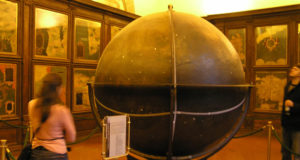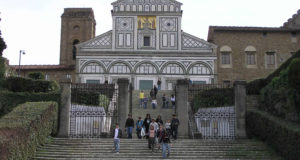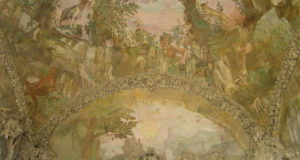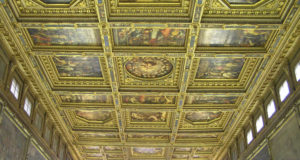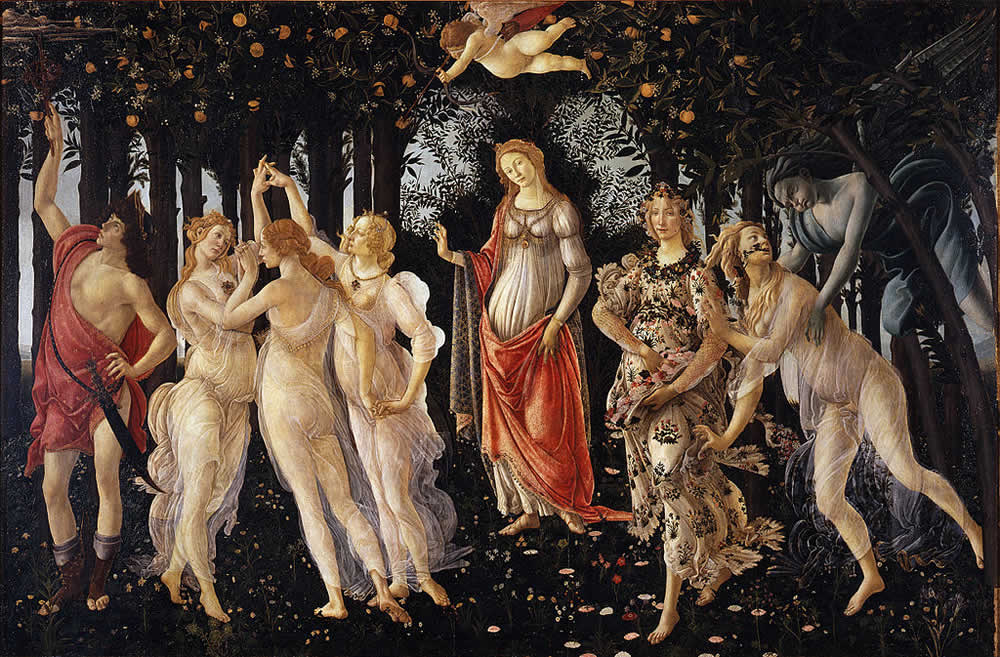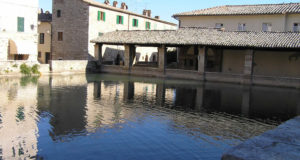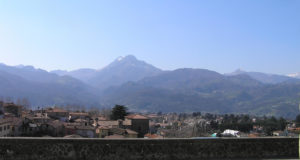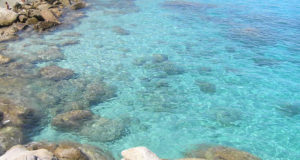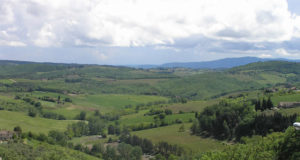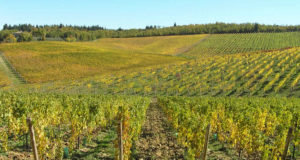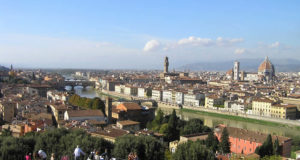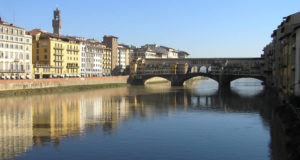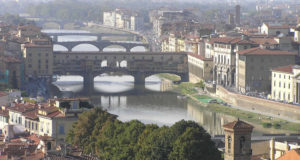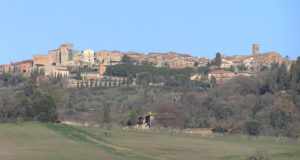At the end of the museum itinerary is the Hall of Geographical Maps (Sala delle Carte Geografiche) or Stanza del Guardaroba. In this room was originally the Medici Wardrobe of Grand Duke Cosimo I. That is, the seat of the institution that preserved, inventoried and moved all the assets of the State and the Sovereign. The room has a beautiful ...
Read More »Basilica of San Miniato al Monte
A masterpiece of Tuscan Romanesque in Florence The Basilica of San Miniato al Monte rises on a hill to south-east of the historical center of Florence, near Piazzale Michelangelo, and is considered one of the finest examples of Florentine Romanesque style. Built between the eleventh and the thirteenth century, contains works of great value as the chapel of the Cardinal ...
Read More »Grotta del Buontalenti: a grotto in the Boboli Gardens
The Buontalenti Grotto was built, designed and conceived between 1583 and 1593 by Bernardo Buontalenti (Florence 1536-1608). This Grotto is one of the most important places in the Boboli Gardens, it is an artificial cave filled with false stalactites and stalagmites, with statues of sheep, shepherds and Roman gods. Buontalenti Grotto represents one of the most valuable examples of Mannerist ...
Read More »Val d’Orcia: natural landscape modeled by man
In 2004, the Val d’Orcia was registered by UNESCO as a world heritage landscape area, with the following reasons: “… it is an exceptional example of how the natural landscape was redesigned in the Renaissance period to reflect the ideals of good governance and create an aesthetically pleasing image.” The landscape of this area of Tuscany is very beautiful. Renaissance ...
Read More »Salone dei Cinquecento in Palazzo Vecchio, Florence
The Salone dei Cinquecento was built in 1495, during the period of restoration of the Florentine Republic. That is, after the expulsion of Piero de’ Medici in 1494. The work was done by Simone del Pollaiuolo called “il Cronaca” (1457-1508) assisted by Francesco di Domenico and Antonio da Sangallo. The huge hall was built at the behest of Frà Girolamo ...
Read More »Chiusi: an important Etruscan city in the Val di Chiana
Chiusi lies in the extreme south of the Valdichiana on a hill at approximately 400 amsl. it’s a famous city for its Etruscan tombs and its historical center. The city is reached in car from Florence or Rome through the Highway of the Sun (Autostrade del Sole, A1), exit Chiusi-Chianciano Terme, from the exit are 3 km more. The distance ...
Read More »Pieve di Gropina: a splendid Romanesque church
The Pieve of Gropina, is located about 2 km from Loro Ciuffenna, on the Via dei Sette Ponti (road of the Seven Bridges) towards San Giustino, to get there take a detour to the right, which after 800 metres from the junction leading to the village of Gropina. A MASTERPIECE OF ROMANIC ART The beautiful Romanesque church of Pieve of ...
Read More »Loro Ciuffenna: a suggestive medieval village
The village is situated on the slopes of Pratomagno at 328 meters above sea level, the actual center is of medieval origin but Loro Ciuffenna has more ancient origins, infact in the area were found Etruscan and Roman artifacts. During the early Roman period, the Lorese territory was crossed by the Cassia Vetus (the path is still very similar to ...
Read More »Uffizi Gallery: the most important museum of Florence
Uffizi Gallery is the most important museum of Florence and one of the most famous museums in the world. The building houses a superb collection of works of art, divided into several rooms arranged for schools and styles in chronological order. This is an immense artistic heritage, which includes thousands of pictures ranging from the medieval to modern, a large ...
Read More »The farmhouses in Tuscany: in contact with nature
The Agriturismo is a typically Italian hospitality system. Over the years, this tourist reception system has taken on an increasingly tourist and less and less agricultural dimension. By developing facilities that provide the customer with numerous comforts and services such as swimming pools, massages, saunas, riding stables, etc. Tuscany is the Italian region that has the largest number of farmhouses. ...
Read More »The Spas of Tuscany: the region richest in spas
Tuscany, among the Italian regions, is without doubt the most rich in spas, just to mention some popular locations in the world as Montecatini Terme, Chianciano Terme, Saturnia. This region is in fact rich in deposits of thermal water that make it together with Emilia Romagna and Veneto, the most important Italian region for spas. Tuscany is a region that ...
Read More »Apuan Alps: the Marble Mountains
The Apuan Alps are probably the most beautiful mountains of Tuscany, located near the sea between Garfagnana and Lunigiana are universally famous for the marble that is extracted from its quarries since antiquity. MARBLE MOUNTAINS The mountains are rugged and inaccessible and recall, for their rugged form, the Dolomites. Apuan Alps are now a Regional Natural Park (Parco naturale regionale ...
Read More »Islands of the Tuscan Archipelago
Tuscan Archipelago is a group of islands located between the Tuscan coast and Corsica, it consists of seven main islands and several smaller islets with a total area of 300 sq. km. The largest island of the archipelago is the island of Elba (225 sq km, 31.000 inhabitants), which alone accounts for more than two thirds of the total area ...
Read More »Itinerary in the Sienese Chianti
For the part of the itinerary in the Sienese Chianti we can start from Siena and from here with the SR 222 reach Castellina in Chianti. Otherwise, continuing the itinerary of the itinerary of Florentine Chianti, from San Donato in Poggio, we reach Castellina in Chianti. CASTELLINA IN CHIANTI Castellina in Chianti is a splendid town situated in an equally splendid ...
Read More »Itinerary in the Florentine Chianti
Our itinerary in Florentine Chianti starts from the city of Florence. The starting point is the Firenze-Impruneta (ex Firenze-Certosa) exit of the Autostrada del Sole. The first stop is the town of San Casciano in Val di Pesa. Along the route we can make a detour of a few kilometers to visit the famous Albergaccio del Machiavelli. This is located ...
Read More »Chianti: the hilly heart of Tuscany
Chianti, ie the territory which for centuries produced the wine Chianti Classico, is part of the Tuscan hill land situated between Florence and Siena, expertly shaped by man and rich of art, this area is a mosaic of history, nature and art unique in the world. This is a land of ancient traditions, civilized in ancient times, first by the ...
Read More »Piazzale Michelangelo: the viewpoint of Florence
Piazzale Michelangelo is together with the Forte di Belvedere, the Basilica of San Miniato al Monte and the hill of Fiesole, one of the privileged viewpoints over Florence. The Piazzale designed in 1860 by the architect Giuseppe Poggi, is located on a hill south of the Arno and the historic center of Florence. This belvedere was built in 1865, at ...
Read More »Ponte Vecchio: the most famous bridge in Florence
The Ponte Vecchio is the oldest bridge in Florence, its origin dates back to Roman times. But it was repeatedly damaged by the floods of the Arno. Following this it was rebuilt several times. The structure crosses the river at its narrowest point and is today one of the symbols of the city of Florence. In medieval times it was ...
Read More »The climate of Florence: when to go to Florence
The city of Florence has a temperate Mediterranean climate, with hot, dry summers and cold, damp winters. The climate of Florence is influenced by its location in a valley at the foot of the Apennines to the north and surrounded by the hills of Chianti to the south. Summers are very hot with average maximum temperatures of over 30 ° ...
Read More »Casole d’Elsa: a typical village of Val d’Elsa
Casole d’Elsa is a small town in the Val d’Elsa, which has less than four thousand inhabitants, the place is a beautiful medieval village that is located in a dominant position on a hill 417 meters high and about 14 km from Colle Val d’Elsa. The history of Casole d’Elsa dates back to the eleventh century when Volterra founded a castle ...
Read More »Lunigiana: land of medieval castles and churches
Lunigiana is an area of north-western Tuscany, embedded between Liguria and Emilia Romagna, and formed by the High and Middle Valley of the river Magra. Its name comes from the ancient city of Luni, a Roman colony that was of major importance for the area until the early Middle Ages. In prehistoric times in the Lunigiana has flourished the megalithic culture of Statues ...
Read More » Borghi di Toscana Guida ai borghi e ai paesaggi della Toscana
Borghi di Toscana Guida ai borghi e ai paesaggi della Toscana
